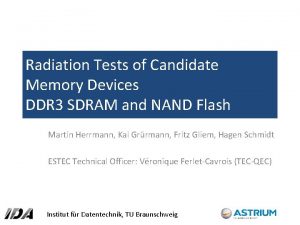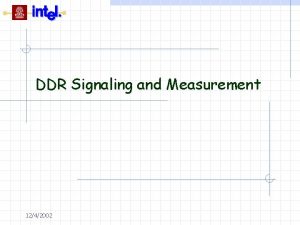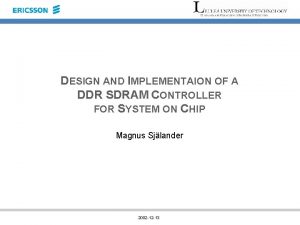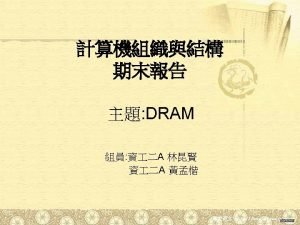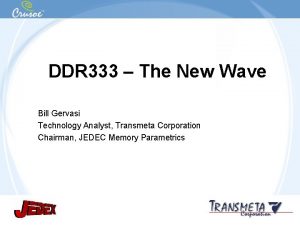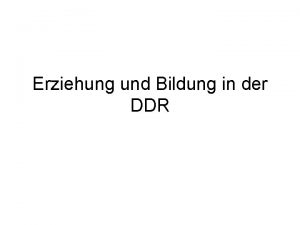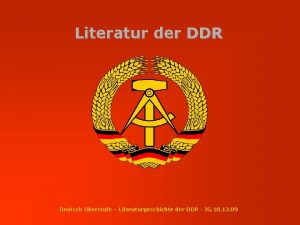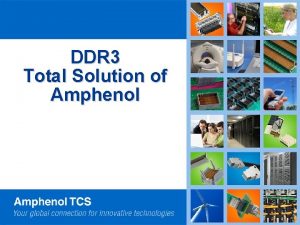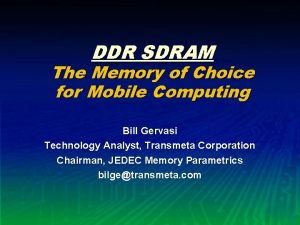DDR Memory what is it Understanding DDR Memory













- Slides: 13

DDR Memory – what is it?

Understanding DDR Memory • Double Data Rate Memory – Read/Write on both Rising and Falling Edge • 2 x Speed without increasing CLK frequency • Faster Transitions – Low Voltage (2. 5 V, 1. 8 V, 1. 5 V) • Lower Threshold Voltages • Lower noise margin

Understanding DDR Memory • Conventional Logic – Fixed Input Threshold – High Impedance Termination – Terminated to I/O Supply • Stub Logic (DDR Memory) – ½ VIO Threshold – Low Impedance Termination – Terminated to ½ I/O Supply

VDDQ, VTT What does it all mean? • VDDQ – VCC – Memory Core Power – VDD – Memory Logic Power – VI/O – Input/Output Stage Power • 2. 5 V (DDR), 1. 8 V (DDR 2) or 1. 5 V (DDR 3) • 3% Accuracy, 1. 5% ripple, 50 m. V transient • VTT_Ref – Typically less than 1 m. A / device – Low Current Logic Threshold Level • ½ VDDQ • 2% Accuracy, <10 m. V ripple • VTT – High-Current Termination Voltage • VTT_Ref • 20 m. V Accuracy, 1% ripple, 40 m. V transient

VDDQ, VTT, What does it all mean? • VDDQ – Provides Core, Logic and I/O Power • Typical low voltages – 2. 5 V on older DDR – 1. 8 V on current DDR 2 – 1. 5 V on newest DDR 3 • Generally Produced with a High-speed switcher – Single Chip can be as low as 1 -2 Amps – Use Single Channel Switcher smaller banks (3 – 15 A) – Use Multi-Channel Switchers for large, multi-DIMM banks – High Transient requirement can require large output capacitor bank.

VDDQ, VTT, What does it all mean? • VTT_ref – Provides Reference for Logic Input-Stage • Must be ½ VDDQ of Source device – Can be generated by Resistor Divider • Typical for up to 4 Chips or 1 DIMM – Generate with active buffer • Less load sensitive – higher accuracy • Higher divider resistance – Less dissipation • Necessary for larger multi-DIMM banks

VDDQ, VTT, What does it all mean? • VTT – High-Current Sink/Source Termination • Source Current for Logic 0 • Sink Current for Logic 1 – High Dynamic Currents • -IMAX to +IMAX at 5 A/ms not uncommon • 40 m. V transient response • Typical requires large bulk capacitance – Typically generated with Tracking Switcher OR Sink/Source LDO • Tracking Switchers may require external resistor divider • Standard LDO’s can-not sink current

VTT Termination – Passive • Simple Resistor Termination • 90 m. A Termination • 162 m. W Dissipation • Inexpensive • Poor Performance • Lower Through Put • Higher Bit-Error

Passive Termination - Loading

How Much Power do I need? • VTT_REF – Low Current Requirement – Typically less than 1 m. A / device – VTT_REF leakage current typical given in DDR IC or DIMM datasheet

How Much Power do I need? • VTT – Typically NOT given in datasheet – Depends on Address & Datalines • DDR – Can be as high as 20 m. A / data/address bit channel • DDR 2 – Can be as high as 18 m. A / data/address bit • DDR 3 – Can be as high as 15 m. A / data/address bit – Can have upto 2 x start-up current due to Active Termination / Capacitive Load

How Much Power do I need? • VDDQ – In Datasheet • Datasheets list IDDQ for every mode – Not all IC/DIMMS in highest current mode at once • Typical estimate highest IDDQ mode for 1 IC/DIMM + 50% for each additional IC/DIMM • Given in “No Load” condition – Does not include VTT current • Must Source VTT current to output Logic 1 s – Increase by VTT current for I/O when Output All 1 s. • IDDQMAX = IDDQ(datasheet) + VTTMAX

Integrated Memory Example • Micron 2 GB Memory IC • 84 pin IC • IDDQ(max) = 350 m. A • ITT(max) = 13. 5 m. A * 34 lines = 460 m. A • 16 data, 14 address, 4 command • VDDQ = 1. 8 V @ 810 m. A • VTT = 0. 9 V @ 460 m. A
